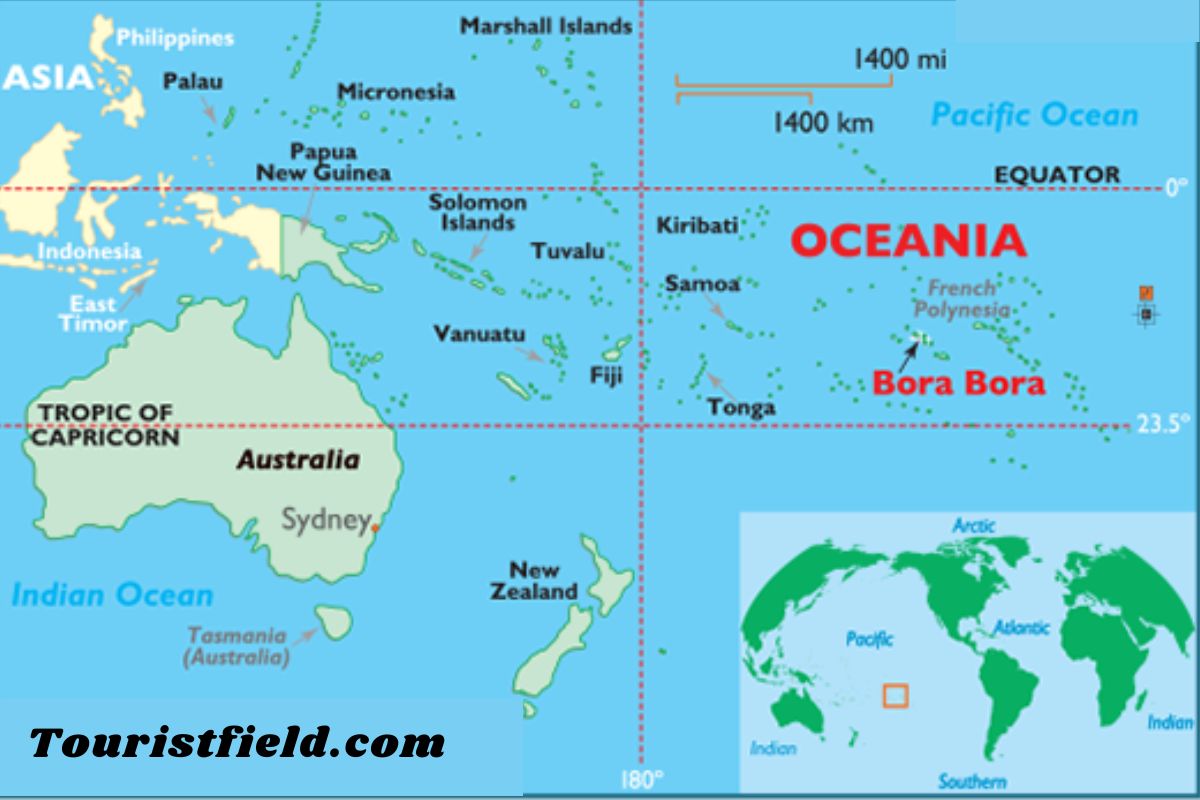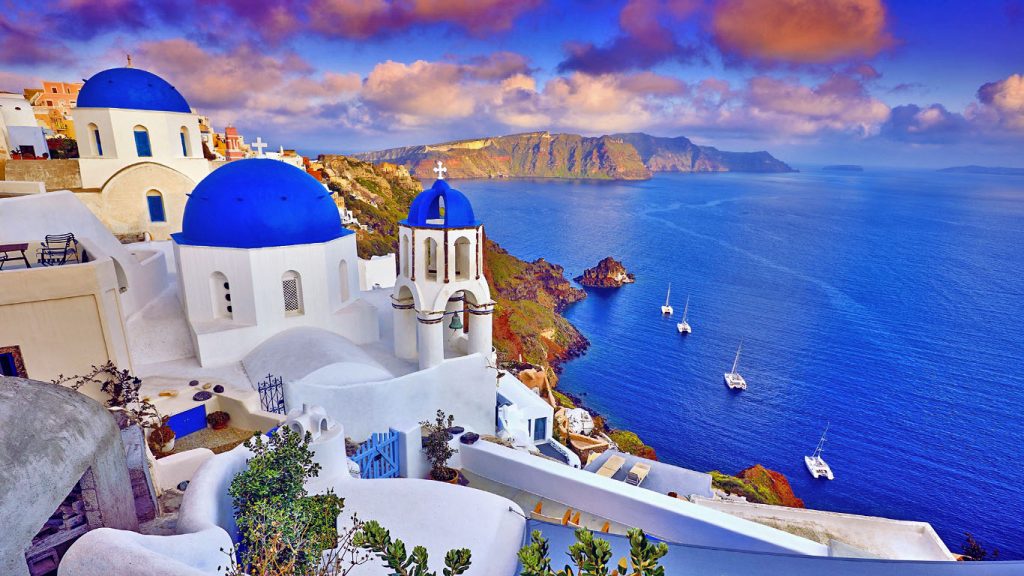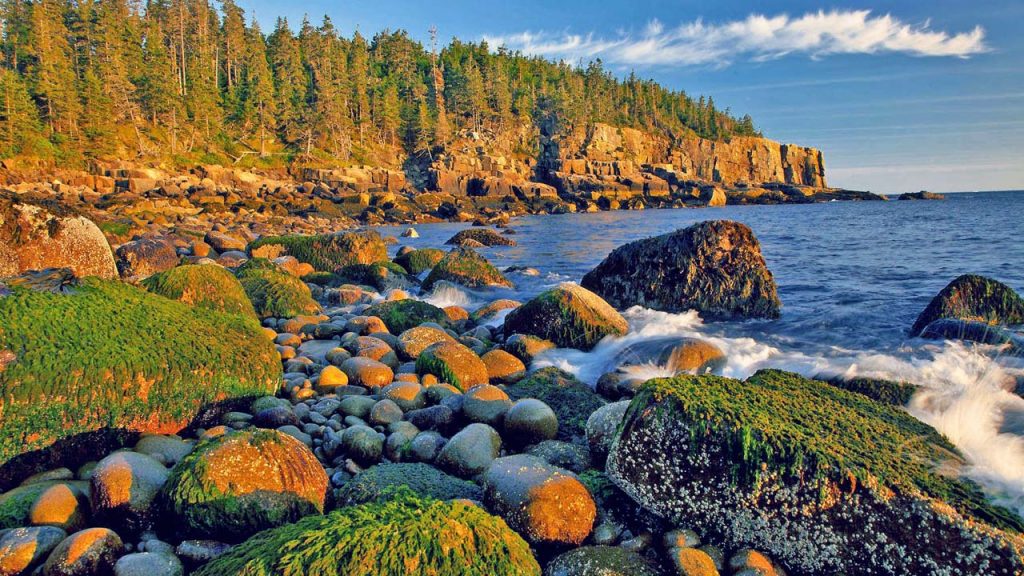Geography of Bora Bora: A Paradise Uncovered
Discover Bora Bora’s fascinating geography – from its stunning location in the South Pacific to the iconic Mount Otemanu. Immerse yourself in the tropical climate, vibrant flora and fauna, and unique cultural tapestry. Explore the future possibilities and challenges of this beautiful paradise.
Introduction:
Welcome to the enchanted world of Bora Bora, a jewel in the heart of the South Pacific. This article uncovers the geographical wonders that make Bora Bora an unparalleled destination. Let’s take a journey through its coordinates, physical features, climate, and more. Another aspect of Bora Bora’s geographic significance is its tropical climate. Consistent warmth throughout the year with a dry season from May to October contributes to the island’s popularity among tourists. This climate creates an ideal backdrop for the thriving tourism industry that has become synonymous with the name Bora Bora.
Overview of Bora Bora’s geographical significance
Bora Bora, often hailed as the “Pearl of the Pacific”, holds great geographical significance, captivating the hearts of travelers worldwide. This small island is located in the South Pacific Ocean, and its coordinates are approximately 16.5000° S latitude and 151.7500° W longitude, placing it within the Society Islands of French Polynesia.
The geographical charm of the island is anchored in its stunning physical features. At the heart of Bora Bora stands Mount Otemanu, a dormant volcano that not only adds to the island’s natural beauty but also holds cultural and historical significance. The surrounding lagoon, surrounded by a vibrant barrier reef, paints an enchanting picture, making Bora Bora a haven for nature enthusiasts and those seeking a tropical paradise.
Beyond its physical beauty, the island showcases the unique flora and fauna biodiversity that thrives in this Pacific haven. Visitors can immerse themselves in the vibrant colors of tropical flowers and the rich marine life that surrounds the island. The geological history, marked by volcanic origins, adds an extra layer of fascination to Bora Bora’s geography.
Strategically located within the Society Islands, Bora Bora shares its geographic tapestry with nearby islands such as Tahiti and Raiatea. This interconnectedness forms a collective paradise in the South Pacific, with each island contributing to the region’s rich cultural and natural heritage.
In short, Bora Bora’s geographical significance lies not only in its breathtaking scenery but also in its harmonious blend of cultural, historical, and natural elements. The island coordinates on the map only hint at the wonders that await, inviting travelers to explore and be enthralled by the geographical wonders that Bora Bora has to offer.
Location:
Bora Bora, located at about 16.5000° S latitude and 151.7500° W longitude, is part of French Polynesia. This small island is surrounded by a huge lagoon and barrier reef, creating a picturesque environment that attracts travelers from around the world. Its location contributes to the unique charm and tranquility that defines Bora Bora.
Bora Bora’s coordinates and its place in the South Pacific
Bora Bora, an enchanting paradise located in the vast South Pacific Ocean, is defined by its coordinates which place it on the map at approximately 16.5000° S latitude and 151.7500° W longitude. These geographic coordinates mark the island’s exact location within the Enchanted Archipelago of French Polynesia.
Located in the Society Islands, Bora Bora holds a prominent place in this tropical haven. Its coordinates not only mark its place on the surface of the earth but also as an alluring island destination like no other. Located at a certain latitude and longitude, Bora Bora is located in the cluster of islands that form the heart of the South Pacific Ocean, known for their pristine beauty and enchanting landscapes.
The coordinates, 16.5000° S and 151.7500° W place Bora Bora in a unique geographical setting, surrounded by turquoise waters and vibrant coral reefs. This location plays an important role in shaping the island’s climate, which is characterized by tropical warmth and a gentle breeze, making it an ideal getaway for travelers looking for a slice of paradise.
In essence, Bora Bora’s coordinates act as a geographic gateway, inviting adventurers and nature enthusiasts to explore its breathtaking landscapes and experience the unparalleled beauty that defines this gem in the South Pacific. The precise location within these coordinates captures the essence of Bora Bora’s place in the world – a destination where natural wonders and geographic coordinates combine to create an unforgettable experience.
Physical Characteristics:
The island boasts the majestic Mount Otemanu, a dormant volcano that stands as its highest point. The crystal-clear lagoon surrounding the island, paired with vibrant coral reefs, creates an enchanting underwater world. These physical features make Bora Bora a haven for nature enthusiasts and adventure seekers.
Climate:
Bora Bora experiences a tropical climate, characterized by warm temperatures throughout the year. The climate plays an important role in the island’s thriving tourism industry, which attracts visitors seeking a tropical paradise. The dry season, from May to October, is particularly popular with tourists.
Flora and Fauna:
Bora Bora’s biodiversity is as diverse as its natural scenery. The island is home to unique flora including tropical flowers and coconut palms. The surrounding waters are teeming with colorful fish and marine life, making it a paradise for snorkeling and diving enthusiasts.
Geological History:
Bora Bora’s geological history is fascinating, with the island formed through volcanic activity. Understanding its volcanic origins adds depth to the appreciation of the rugged terrain and rich soil that supports the lush vegetation.
Bora Bora’s fascinating geography finds its roots in a story of ancient volcanic origins, shaping the island’s dramatic landscape and contributing to its unique charm. The formation of Bora Bora can be traced back to the remnants of volcanic activity, creating a setting that captures the imagination of all who set foot in this beautiful paradise.
Formation and volcanic origins
Bora Bora arose from the remnants of a once-active volcano, and evidence of its volcanic origins is visible on the island’s highest point, the majestic Mount Otemanu. Mount Otemanu stands as a sentinel, displaying the geologic forces that have shaped Bora Bora over time. The formation of the island involved the gradual cooling and solidification of volcanic material, giving rise to the distinctive peaks and valleys that characterize its topography.
As the molten lava flowed and the volcanic ash settled, the island began to take its current form, surrounded by a pristine lagoon and decorated with coral reefs. The interaction between volcanic activity and the surrounding waters contributes to the formation of the barrier reef that surrounds Bora Bora, adding to its natural splendor.
Although the volcanic origin is evident in the composition of the island’s soils and soils, Bora Bora is now a dormant volcano. The once-fiery forces that shaped its origins have given way to a tranquil paradise, inviting visitors to witness the parallels between the island’s turbulent past and the serenity it exudes now.
Understanding the geological history of Bora Bora adds a layer of appreciation for its stunning landscape. The interaction of volcanic power, erosion, and time has created a masterpiece in the South Pacific – an island that stands as a testament to Earth’s transformative processes. As travelers explore Bora Bora’s lush valleys, crystal-clear lagoons, and the silhouette of Mount Otemanu, they witness the lasting legacy of the island’s volcanic origins.
Neighboring Islands:
Bora Bora is part of the Society Islands, located near Tahiti and Raiatea. These neighboring islands share similar geological features, forming a collective tapestry of natural wonders in the South Pacific.
Human settlement:
The island is inhabited by indigenous Polynesians, whose culture is deeply intertwined with the geography of Bora Bora. Visitors can experience the warmth of local hospitality and witness traditional practices passed down from generation to generation.
Economy:
Bora Bora’s primary economic driver is tourism. The island’s topography, combined with its welcoming culture, attracts visitors seeking luxury resorts, overwater bungalows, and a unique blend of relaxation and adventure.
Infrastructure:
Despite its remote location, Bora Bora has a well-developed tourist infrastructure. Transportation options including boat transfers and flights ensure seamless access. There are modern utilities to enhance the overall experience of the visitors
Conservation Efforts:
To preserve its pristine environment, Bora Bora has implemented various conservation measures. These initiatives aim to protect delicate ecosystems including coral reefs and native species, ensuring the sustainability of this natural paradise.
Popular attractions:
From the iconic Matira Beach to the panoramic viewpoints around Mount Otemanu, Bora Bora offers countless attractions. Each spot captures the essence of the island’s geography, offering breathtaking views and memorable experiences.
Popular attractions: Uncovering the essential wonders of Bora Bora
Bora Bora, with its mesmerizing beauty and varied geography, offers a plethora of attractions that leave an indelible mark in the heart of every traveler. From pristine beaches to cultural landmarks, the island beckons explorers to explore its unique attractions.
Matira Beach:
Matira Beach stands out as a postcard-perfect destination, famous for its powdery white sand and crystal-clear turquoise waters. This stretch of coastline invites visitors to bask in the warmth of the sun, take leisurely walks on the shores, and witness the mesmerizing sunsets that paint the sky orange and pink.
Mount Otemanu Viewpoint:
For a scenic view, exploring the viewpoints around Mount Otemanu is a must. Be it from peaks or designated lookout points, these locations offer breathtaking views of the island’s volcanic peaks, lush landscapes and expansive lagoons. The scenery encapsulates the essence of Bora Bora’s geographical splendor.
Coral Gardens:
Dive into the underwater wonders of Bora Bora by visiting the Coral Gardens. Snorkeling enthusiasts can marvel at vibrant coral formations and a kaleidoscope of marine life. Clear water provides an unparalleled opportunity to witness the biodiversity that thrives beneath the surface.
Bora Bora Lagoonarium:
For an immersive marine experience, the Bora Bora Lagoonarium is a must-see. This natural aquarium allows visitors to interact with stingrays, sharks, and numerous colorful fish. This is an opportunity to see marine life up close in a controlled and safe environment.
Matira Point:
Matira Point offers not only stunning views but also a chance to witness the confluence of the lagoon and the Pacific Ocean. This geographical feature provides a lovely setting for photography and contemplation, surrounded by the soothing sound of lapping waves.
On VITAP:
Bora Bora’s main village, Vaitape, introduces visitors to the local way of life. Explore lively markets, interact with locals, and taste traditional Polynesian cuisine. The cultural richness of Vaitap adds a layer of authenticity to the overall Bora Bora experience.
Fa’anui Valley:
Nature enthusiasts will find solace in the lush greenery of the Fa’anui Valley. This green oasis offers hiking trails amidst tropical vegetation, providing a serene escape in the heart of Bora Bora’s interior. The valley is a haven for bird watchers and those seeking a quiet retreat.
Bora Bora Turtle Center:
Dedicated to conserving marine life, the Bora Bora Turtle Center allows visitors to learn about and interact with sea turtles. This is a unique opportunity to contribute to conservation efforts while gaining insight into the island’s commitment to preserving natural resources.
Bay of Fanui:
Fainui Bay, with its calm waters and charming surroundings, offers a peaceful escape. Kayaking or paddleboarding in the bay offers a different perspective of Bora Bora, allowing visitors to appreciate the island’s geography from a calm aquatic space.
Anau Sunset Cruise:
To cap off the Bora Bora experience, an Anu Sunset Cruise is a must for a romantic and scenic excursion. As the sun sinks below the horizon, casting hues of gold and crimson across the sky, visitors can enjoy the beauty of Bora Bora from the calm waters of the lagoon.
These must-see spots capture Bora Bora’s diverse geography, inviting travelers to immerse themselves in the island’s natural wonders, cultural richness, and unparalleled beauty. Each destination adds a unique chapter to the story of Bora Bora, leaving visitors with cherished memories of this South Pacific paradise.
Activities:
Visitors can indulge in a variety of activities, from water sports like snorkeling and paddleboarding to exploring hiking trails that offer panoramic views. Cultural experiences, such as traditional dance performances, provide a deeper connection to the local way of life.
Activities in Bora Bora: A triad of adventure, nature, and cultural immersion
Bora Bora, with its captivating geography, offers a trifecta of activities that cater to adventure enthusiasts, nature lovers, and those looking to dive deeper into the island’s rich culture. From exhilarating water sports to scenic hikes and immersive cultural experiences, the island offers a variety of activities for every traveler.
Water sports:
Bora Bora’s azure lagoon, teeming with marine life, serves as a playground for water sports enthusiasts. Snorkeling is a must, allowing visitors to explore vibrant coral gardens and encounter an array of tropical fish. For a more adventurous experience, diving trips offer glimpses of the diversity of the underwater world, from manta rays to sharks.
Paddleboarding and kayaking provide a leisurely way to navigate the calm waters surrounding the island. The lagoon’s clarity allows for a unique perspective with the vibrant colors of the coral visible beneath the surface. Parasailing offers an adrenaline-pumping adventure, providing breathtaking aerial views of Bora Bora’s geography.
Hiking Adventures:
For those interested in exploring Bora Bora’s lush landscape on foot, the hiking trails offer an impressive journey. The Fa’anui Valley, with its lush surroundings, presents an opportunity for nature enthusiasts to travel among tropical flora. Trails lead to scenic overlooks, which provide panoramic vistas of Mount Otemanu and the island’s interior.
The Matira Ridge Hike provides another vantage point, allowing hikers to witness the interplay of the lagoon and the Pacific Ocean. The varying elevations provide a dynamic hiking experience, with each step uncovering the varied topography that defines Bora Bora.
Cultural Immersion:
Bora Bora’s cultural tapestry is woven with the traditions of its indigenous people. Visitors can engage in cultural experiences that provide insight into the island’s rich heritage. A visit to Vaitap, the main village, offers an opportunity to explore the local market, which displays vibrant handicrafts and traditional Polynesian artifacts.
Cultural dance performances, showcasing traditional Tahitian dance and music, offer a fascinating glimpse into Bora Bora’s artistic expression. The warm hospitality and friendliness of the islanders contribute to an immersive cultural experience, allowing travelers to connect with the local way of life.
Attending a Polynesian feast known as ‘Tamara’ introduces visitors to the island’s cuisine. Traditional dishes influenced by geography, such as fresh seafood and tropical fruits, are served against a backdrop of cultural offerings, creating a feast for the senses.
In essence, Bora Bora beckons travelers not only to appreciate its geographical wonders but also to actively engage with its environment through thrilling water sports, lively hiking, and culturally enriching experiences. The island’s activities cater to a spectrum of interests, ensuring that every visitor finds a piece of Bora Bora that resonates with their sense of adventure and appreciation for diverse experiences.
Local Cuisine:
Bora Bora’s geography influences its culinary offerings. Fresh seafood, tropical fruits, and traditional dishes showcase the flavors of the island. Visitors can savor a gastronomic journey that reflects the richness of the landscape.
Future Prospects:
As Bora Bora strikes a delicate balance between tourism and conservation, sustainable development is on the horizon. The island aims to preserve its geographical wonders while meeting the growing demands of discerning global visitors.
Geography of Bora Bora: FAQs
Question: What makes Bora Bora’s geography unique?
Answer: Bora Bora’s uniqueness lies in its combination of a volcanic past, stunning lagoons, and barrier reefs. It creates a visually appealing landscape that sets it apart from other destinations.
Question: Are there any conservation efforts in place?
Answer: Yes, Bora Bora actively implements conservation measures to protect its environment. These include initiatives to conserve coral reefs, marine life, and overall ecosystems.
Question: What activities can tourists enjoy in Bora Bora?
Answer: Tourists can engage in a variety of activities including snorkeling, diving, hiking and cultural experiences. The diverse geography caters to both relaxation and adventure.
Question: How has geography influenced the local cuisine?
Answer: The island’s geography, surrounded by abundant water and fertile land, contributes to a rich culinary tradition. Fresh seafood and tropical fruits play a prominent role in the local cuisine.
Question: Is Bora Bora easily accessible?
Answer: Despite its remote location, Bora Bora is accessible by boat and plane. Well-developed infrastructure ensures a smooth journey for visitors.
Question: What is the significance of Mount Otemanu?
Answer: Mount Otemanu is a dormant volcano and the highest point on the island. Its geological significance adds to Bora Bora’s allure, offering stunning views and hiking opportunities.
More Bora Bora blogs:
- Bora Bora Best Time to Go
- Bora Bora on the world map
- where is the Bora Bora map
- where is Bora Bora on the world map
- French Polynesia attractions
- Bora Bora tourist attractions
- Bora Bora tour
- Tahiti tour
- Bora Bora Honeymoon Resort
Conclusion:
In the heart of the South Pacific lies Bora Bora, a destination that transcends the ordinary and invites travelers to a realm where geography and beauty intertwine. As you explore this beautiful island, it becomes clear that Bora Bora is more than a geographical location – it is a living canvas, painted with strokes of volcanic origin, pristine beaches, and cultural richness.
Bora Bora’s geography, marked by the iconic Mount Otemanu and surrounded by a crystal-clear lagoon, sets the stage for an enchanting experience. Dormant volcanoes, a testament to the island’s volcanic origins, add a touch of mystery to the landscape, while lagoons and coral reefs contribute to an underwater world that captivates the imagination.
From the famous Matira Beach to the sights around Mount Otemanu, Bora Bora’s geography showcases the varied aspects. Each destination, with its panoramic views and natural wonders, tells an island story that is both breathtaking and inviting.
Conclusion: Bora Bora – where geography uncovers paradise
Engaging in water sports, hiking adventures, and cultural experiences allows visitors to actively connect with the geography of Bora Bora. Whether snorkeling in coral gardens, hiking in Faanui Valley, or immersing yourself in traditional dance, each activity becomes a brushstroke, adding depth to the canvas of memories created in this Pacific paradise.
As Bora Bora balances tourism with conservation efforts, the island sets a path toward a sustainable future. The delicate balance between preserving its natural wonders and welcoming world travelers reflects a commitment to protecting the geography that makes Bora Bora an unloved destination.
In the Grand Tapestry of Bora Bora, where turquoise waters meet lush greenery, visitors discover not just a place but an experience that transcends the ordinary. The geography of the island reveals itself as a testament to the transformative power of the earth and the resilience of nature. Bora Bora is a sanctuary where travelers can marvel at geographical wonders, indulge in thrilling adventures, and immerse themselves in a culture that resonates through the ages.
In conclusion, Bora Bora stands as a testament to the harmonious coexistence of geography and paradise. It beckons those who want to escape into the lap of nature, offering a glimpse of a world where every sunrise is a masterpiece and every sunset a symphony. As we say goodbye to this South Pacific jewel, the echoes of its geography linger, inviting future explorers to discover their slice of paradise in the geography of Bora Bora.



